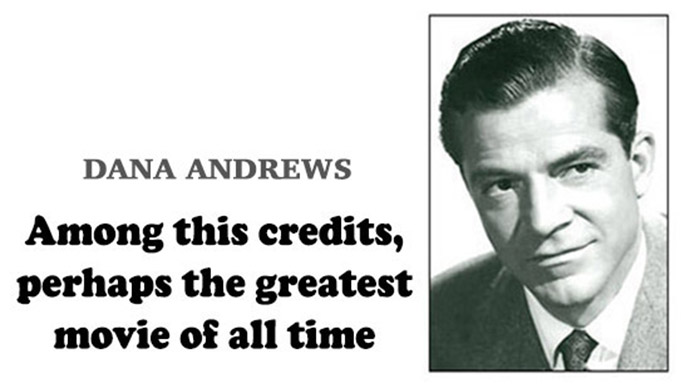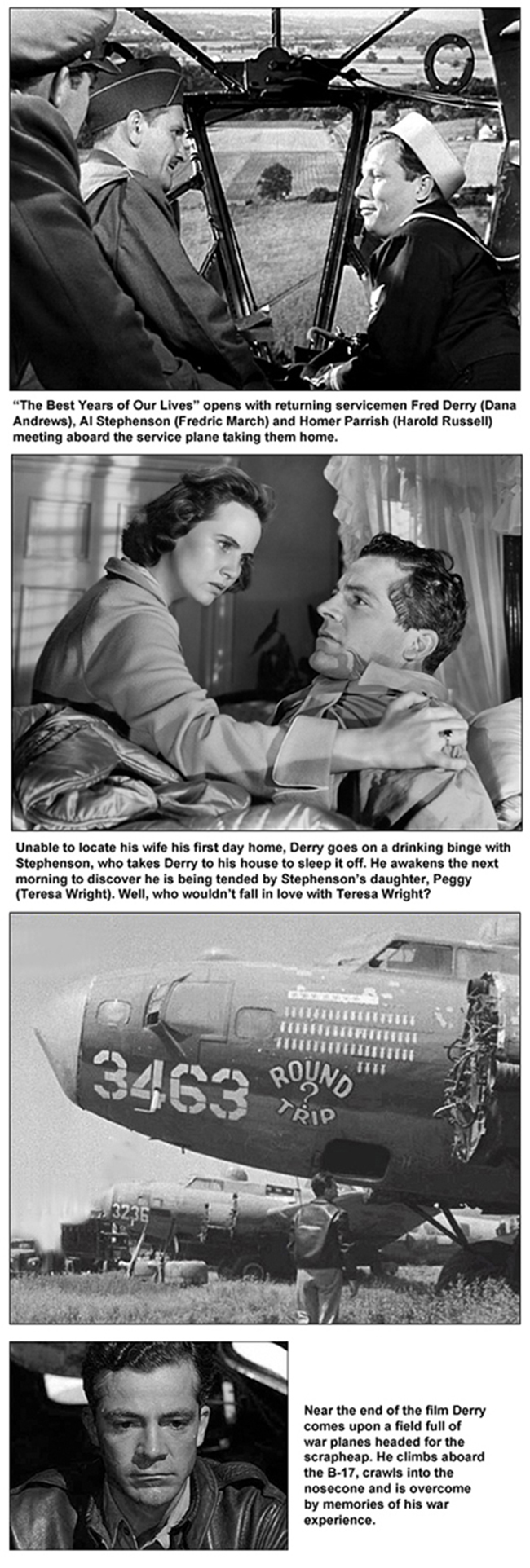| HOME |
 |
 |
The greatest movie of all time? "The Best Years of Our Lives." That's the conclusion I reached about 25 years ago, but should have reached much earlier ... because then I might would have mentioned my feelings during two phone interviews with one of the film's stars – Dana Andrews. The movie was made in 1946 when Andrews was one of Hollywood's hottest, most popular actors. Two years earlier he had starred with Gene Tierney and Clifton Webb in the film noir classic, "Laura." "The Best Years of Our Lives" focused on three returning World War II veterans and the adjustments they were forced to make in a country that had changed considerably while they were overseas fighting to preserve freedom for the folks back home. I was only eight years old at the time, too young to appreciate the movie that dominated the Academy Awards when they were presented in 1947, with wins in eight of the nine categories for which it was nominated. It wasn't until 1990 or so when I watched the movie again – and again – on Turner Classic Movies that I fully appreciated "The Best Years of Our Lives" or considered both the irony and the truth of the title. The Dana Andrews I first interviewed in 1962 was making a personal adjustment to changes in his life and career. He no longer was a leading man and the few offers he was receiving were for films that didn't measure up to those he made in the 1940s and early '50s. He didn't think much of television, but was resigned to accepting roles for the small screen and was even trying to develop his own series. He thought he had a chance to re-establish himself as a leading man when he replaced Henry Fonda on Broadway in "Two for the Seesaw." He hoped he'd be asked to do the movie version, but that role went to Robert Mitchum. "I don't know how they cast the movie," he told me. "They got Shirley MacLaine for the female lead. Anne Bancroft did it on Broadway and Anne is the most talented woman I've ever worked with. I can't figure it out." According to a Wikipedia article, producers of the movie actually wanted Paul Newman and Elizabeth Taylor, strange choices, except maybe for "Cat on a Hot Tin Roof 2." Fonda, Andrews and Mitchum were all somewhat similar ... cool and laconic. But Newman? Not only younger, but much more dynamic, perhaps too much so for the role of a laid-back lawyer from Nebraska who moves to New York to recover from a failed marriage. In any event, "Two for the Seesaw" was no great shakes as a film, and Andrews, like other fading movie stars, turned to the tube. The series he mentioned during our first interview never panned out. He had partnered with writer-producer Stirling Silliphant, who was riding high with two TV hits, "Naked City" and "Route 66." The Andrews-Silliphant project concerned a marriage counselor. A pilot film was done on location in Chicago, but NBC rejected it. (In 1965 a Siliphant screenplay, "The Slender Thread," became a movie starring Anne Bancroft with Sidney Poitier; in 1967 he won an Oscar for his screenplay for "In the Heat of the Night," also starring Poitier.) Andrews was 53-year-old when we talked the first time. His best days were behind him, but he had an interesting view of the future. VCRs, video tapes and DVDs were unknown at the time, but the actor was convinced people would soon be paying to watch movies at home. He saw it as the best way for people to get the films they wanted ... and the best way for Hollywood to gauge the kind of films to make. It also would make commercials unnecessary, and if there's anything that annoyed Andrews, it was television commercials and actors who did them. (Years later Andrews would do a public service message on the subject of alcoholism, a disease that nearly ended his career.) By my second interview with Andrews, in 1969, he had done what formerly was unthinkable – taken a starring role in a daytime soap opera, "Bright Promise," set in a college town, with the actor playing a college president. Because he was criticized for making this decision, he tended to overstate his enthusiasm for the project. "I enjoy this show. I really do. I mean I really enjoy it. I'm an actor and this is an actor's show. It's a very happy experience. It really is. "People said they were shocked that the actor who starred in 'Laura' would stoop to such a thing," he said. "They forget that was 25 years ago. I'm a lot older now – I'm 59 – and I can't go on playing the romantic lead in movies. "Besides, the people on 'Bright Promise' are as good or better actors than I worked with in movies. The acting is much more realistic than you'll see either in movies or nighttime television. I'd say my experience with 'Bright Promise' is every bit as satisfying as doing my two most successful films, 'Laura' and 'The Best Years of Our Lives.' " Some of the other actors in the show were Colleen Gray, Gail Kobe, Anne Jeffreys, Annette O'Toole, Dabney Coleman and Anthony Geary. "Bright Promise" lasted two-and-a-half years. Because he was soft-spoken and unusually handsome, Dana Andrews may have been underrated as an actor. He made it look easy, though it turned out he was self-conscious and nervous and had to work very hard to appear otherwise. The drinking helped. Yet he delivered the goods and played important roles in several great films. In addition "Laura" and "The Best Years of Our Lives," Andrews did "The Ox-Bow Incident" (1943), with Henry Fonda; "Up in Arms" (1944), with Danny Kaye; "The Purple Heart" (1944); "A Walk in the Sun" (1945); "Boomerang!" (1947); "Daisy Kenyon" (1947), with Henry Fonda and Joan Crawford, and "Where the Sidewalk Ends" (1950). In 1943, when the 34-year-old Andrews starred with Tyrone Power and Anne Baxter in "Crash Dive," he helped his younger brother, 19-year-old William Forrest Andrews, get a bit part in the film. The teenager changed his name to Steve Forrest, who then carved out a successful movie and television career on his own. Dana Andrews was born Carver Dana Andrews in Mississippi, though his family moved to Texas when he was a youngster. He married his first wife, Janet Murray, in 1932, but she died three years later. In 1939 he wed Mary Todd, and they remained together 53 years, until his death in 1992. Andrews' career provided some interesting trivia in the realm of airplane disaster movies and spoofs thereof. In 1960 he played an airline pilot in "The Crowded Sky," in which his plane collided with military jet flown by Efrem Zimbalist Jr. So when a similar film was made 15 years later, who better to play the colliding pilots? Only in "Airport '75" it was Zimbalist at the controls of a 747 and Andrews having a heart attack in his private plane. Further, in 1957's "Zero Hour," Andrews played Lt. Ted Stryker, an Air Force pilot who falls apart after a bad combat decision. Years later, in trying to mend his relationship with his wife and son, he follows them aboard a commercial airplane which encounters a crisis in flight when the crew and many passengers get food poisoning. Who will fly the plane? The reluctant Stryker takes over. If it sounds familiar, you probably saw the spoof, "Airplane." Finally, back to "The Best Years of Our Lives" and two of Hollywood's most moving and memorable scenes. The first: when Andrews, as Fred Derry, a bombardier during the war, decides to leave home. His marriage has crumbled, the young woman he loves (Teresa Wright) has been placed off limits, and there's no job in sight. He wants to take the first flight to anywhere, but is told he'll have to wait awhile. He wanders into a huge field near the airport where there are hundreds, perhaps thousands of war planes waiting to be scrapped. It's like an airplane cemetery, another reminder that he has become obsolete. He stops to look at a B-17, just like the one he was assigned to during the war. He climbs into the nose cone and begins to relive his experiences, breaking into a cold sweat, his emotions broadcast in a pulsating soundtrack. After he is discovered and ordered out of the plane, Derry talks himself into a job. He doesn't leave, after all. Some time passes and he attends the wedding of his friend, Homer (Oscar winner Harold Russell) and Wilma (Cathy O'Donnell). This is a scene that has been building from the opening moments of the film because Homer returned from the war minus both arms, using artificial limbs with hooks instead of hands. He is reluctant to go ahead with the wedding, but Wilma finally convinces him that her love will conquer all. That would be powerful enough, but in the background, as the ceremonies continues, eyes are drawn to Derry exchanging furtive glances with the woman he loves, Peggy (Teresa Wright), daughter of Al Stephenson (Fred March), a returning soldier Derry met on the plane home as the film began. It was a perfect ending to a perfect movie. |
 |
| HOME • STARSTRUCK • CONTACT |